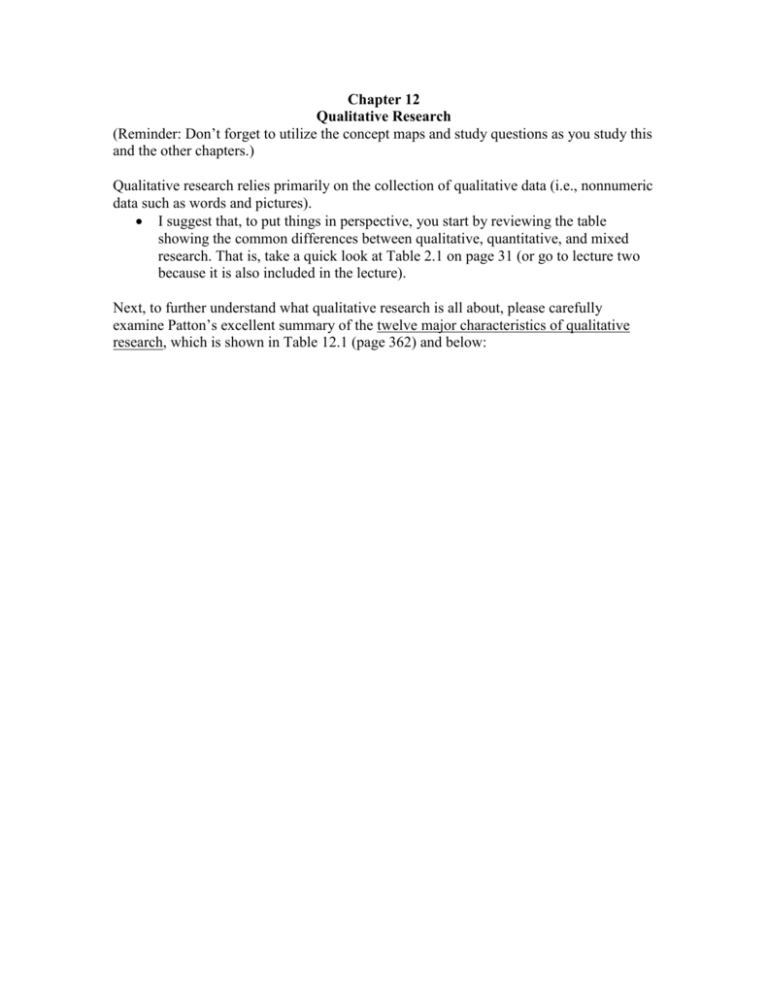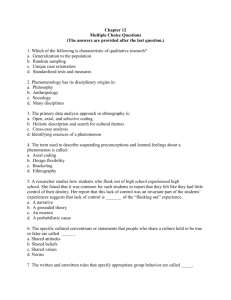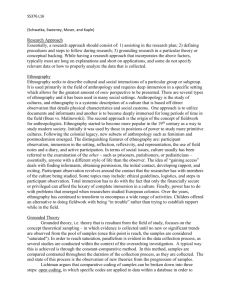lec12
advertisement

Chapter 12 Qualitative Research (Reminder: Don’t forget to utilize the concept maps and study questions as you study this and the other chapters.) Qualitative research relies primarily on the collection of qualitative data (i.e., nonnumeric data such as words and pictures). I suggest that, to put things in perspective, you start by reviewing the table showing the common differences between qualitative, quantitative, and mixed research. That is, take a quick look at Table 2.1 on page 31 (or go to lecture two because it is also included in the lecture). Next, to further understand what qualitative research is all about, please carefully examine Patton’s excellent summary of the twelve major characteristics of qualitative research, which is shown in Table 12.1 (page 362) and below: Now you should understand what qualitative research is. In the rest of the chapter, we discuss the four major types of qualitative research: Phenomenology. Ethnography. Grounded theory. Case study. To get things started, note the key characteristics (i.e., purpose, origin, data-collection methods, data analysis, and report focus) of these four approaches as shown in Table 12.2 on page 363 and below: Phenomenology The first major approach to qualitative research is phenomenology (i.e., the descriptive study of how individuals experience a phenomenon). Here is the foundational question in phenomenology: What is the meaning, structure, and essence of the lived experience of this phenomenon by an individual or by many individuals? The researcher tries to gain access to individuals' life-worlds, which is their world of experience; it is where consciousness exists. Conducting in-depth interviews is a common method for gaining access to individuals' life- worlds. The researcher, next, searches for the invariant structures of individuals' experiences (also called the essences of their experience). Phenomenological researchers often search for commonalities across individuals (rather than only focusing on what is unique to a single individual). For example, what are the essences of peoples' experience of the death of a loved one? Here is another example: What are the essences of peoples' experiences of an uncaring nurse? After analyzing your phenomenological research data, you should write a report that provides rich description and a "vicarious experience" of being there for the reader of the report. Shown next are two good examples. See if you get the feeling the patients had when they described caring and noncaring nurses. Here is a description of a caring nurse (from Exhibit 12.2) based on a phenomenological research study: In a caring interaction, the nurse’s existential presence is perceived by the client as more than just a physical presence. There is the aspect of the nurse giving of oneself to the client. This giving of oneself may be in response to the client’s request, but it is more often a voluntary effort and is unsolicited by the client. The nurse’s willingness to give of oneself is primarily perceived by the client as an attitude and behavior of sitting down and really listening and responding to the unique concerns of the individual as a person of value. The relaxation, comfort, and security that the client expresses both physically and mentally are an immediate and direct result of the client’s stated and unstated needs being heard and responded to by the nurse (From Creswell, 1998, p.289). From the same study of nurses, a description also was provided of a noncaring nurse. Here it is: The nurse’s presence with the client is perceived by the client as a minimal presence of the nurse being physically present only. The nurse is viewed as being there only because it is a job and not to assist the client or answer his or her needs. Any response by the nurse is done with a minimal amount of energy expenditure and bound by the rules. The client perceives the nurse who does not respond to this request for assistance as being noncaring. Therefore, an interaction that never happened is labeled as a noncaring interaction. The nurse is too busy and hurried to spend time with the client and therefore does not sit down and really listen to the client’s individual concerns. The client is further devalued as a unique person because he or she is scolded, treated as a child, or treated as a nonhuman being or an object. Because of the devaluing and lack of concern, the client’s needs are not met and the client has negative feelings, that is, frustrated, scared, depressed, angry, afraid, and upset (From Creswell, 1998, p.289). Ethnography The second major approach to qualitative research is ethnography (i.e., the discovery and description of the culture of a group of people). Here is the foundational question in ethnography: What are the cultural characteristics of this group of people or of this cultural scene? Because ethnography originates in the discipline of Anthropology, the concept of culture is of central importance. Culture is the system of shared beliefs, values, practices, language, norms, rituals, and material things that group members use to understand their world. One can study micro cultures (e.g., such as the culture in a classroom) as well as macro cultures (e.g., such as the United States of America culture). There are two additional or specialized types of ethnography. 1. Ethnology (the comparative study of cultural groups). 2. Ethnohistory (the study of the cultural past of a group of people). An ethnohistory is often done in the early stages of a standard ethnography in order to get a sense of the group's cultural history. Here are some more concepts that are commonly used by ethnographers: Ethnocentrism (i.e., judging others based on your cultural standards). You must avoid this problem if you are to be a successful ethnographer! Emic perspective (i.e., the insider's perspective) and emic terms (i.e., specialized words used by people in a group). Etic perspective (i.e., the external, social scientific view) and etic terms (i.e., outsider's words or specialized words used by social scientists). Going native (i.e., identifying so completely with the group being studied that you are unable to be objective). Holism (i.e., the idea that the whole is greater than the sum of its parts; it involves describing the group as a whole unit, in addition to its parts and their interrelationships). The final ethnography (i.e., the report) should provide a rich and holistic description of the culture of the group under study. Case Study Research The third major approach to qualitative research is case study research (i.e., the detailed account and analysis of one or more cases). Here is the foundational question in case study research: What are the characteristics of this single case or of these comparison cases? A case is a bounded system (e.g., a person, a group, an activity, a process). Because the roots of case study are interdisciplinary, many different concepts and theories can be used to describe and explain the case. Robert Stake classifies case study research into three types: 1. Intrinsic case study (where the interest is only in understanding the particulars of the case). 2. Instrumental case study (where the interest is in understanding something more general than the case). 3. Collective case study (where interest is in studying and comparing multiple cases in a single research study). Multiple methods of data collection are often used in case study research (e.g., interviews, observation, documents, questionnaires). The case study final report should provide a rich (i.e., vivid and detailed) and holistic (i.e., describes the whole and its parts) description of the case and its context. Grounded Theory The fourth major approach to qualitative research is grounded theory (i.e., the development of inductive, "bottom-up," theory that is "grounded" directly in the empirical data). Here is the foundational question in grounded theory: What theory or explanation emerges from an analysis of the data collected about this phenomenon? It is usually used to generate theory (remember from earlier chapters that theories tell you "How" and "Why" something operates as it does; theories provide explanations). Grounded theory can also be used to test or elaborate upon previously grounded theories, as long as the approach continues to be one of constantly grounding any changes in the new data. Four important characteristics of a grounded theory are Fit (i.e., Does the theory correspond to real-world data?), Understanding (i.e., Is the theory clear and understandable?), Generality (i.e., Is the theory abstract enough to move beyond the specifics in the original research study?), Control (i.e., Can the theory be applied to produce real-world results?). Data collection and analysis continue throughout the study. When collecting and analyzing the researcher needs theoretical sensitivity (i.e., being sensitive about what data are important in developing the grounded theory). Data analysis often follows three steps: 1. Open coding (i.e., reading transcripts line-by- line and identifying and coding the concepts found in the data). 2. Axial coding (i.e., organizing the concepts and making them more abstract). 3. Selective coding (i.e., focusing on the main ideas, developing the story, and finalizing the grounded theory). The grounded theory process is "complete" when theoretical saturation occurs (i.e., when no new concepts are emerging from the data and the theory is well validated). The final report should include a detailed and clear description of the grounded theory. Final note: The chapter includes many examples of each of the four types of qualitative research to help in your understanding (i.e., phenomenology, ethnography, case study, and grounded theory). In addition, reading new examples in the published literature will help to further your understanding of these four important approaches to qualitative research.









